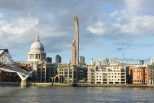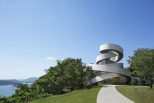Fulton Center, an impressive glass and steel building dominated by a huge transparent dome Designed by Grimshaw and Arup…

It’s Kengo Kuma’s project that speaks of the continuous interest in reconnecting architecture with nature or, to quote the architect, the need “to recover the place”.
 Using architecture as a frame of nature, the project seems to echo a need for experiencing built space through its interaction with the elements and transformations affected by the passage of time. The faceted wall is populated with plants, creating an impression of two tectonic forces, the natural and the artificial, fighting for supremacy.
Using architecture as a frame of nature, the project seems to echo a need for experiencing built space through its interaction with the elements and transformations affected by the passage of time. The faceted wall is populated with plants, creating an impression of two tectonic forces, the natural and the artificial, fighting for supremacy.
 The multi-purpose building is located near the railway station in Odawara, Japan. The façade, achieved by using decayed styrene foam, encompasses the building, leaving the ground floor transparent and accessible. The first floor facilitates a clinic and pharmacy while the upper floors are used for offices. The planters are comprised of aluminium die-cast panels, made in monoblock casting.
The multi-purpose building is located near the railway station in Odawara, Japan. The façade, achieved by using decayed styrene foam, encompasses the building, leaving the ground floor transparent and accessible. The first floor facilitates a clinic and pharmacy while the upper floors are used for offices. The planters are comprised of aluminium die-cast panels, made in monoblock casting.
 Each panel is slanted, and its surface appears to be organic, of which cast comes from decayed styrene foam. Equipment such as watering hose, air reservoir for ventilation and downpipes are installed behind the panels so that the façade can accommodate a comprehensive system for the building. The piping delivers rain water to the aluminum die-cast planters, keeping the whole structure organic and alive.
Each panel is slanted, and its surface appears to be organic, of which cast comes from decayed styrene foam. Equipment such as watering hose, air reservoir for ventilation and downpipes are installed behind the panels so that the façade can accommodate a comprehensive system for the building. The piping delivers rain water to the aluminum die-cast planters, keeping the whole structure organic and alive.
 (Fabiana Cambiaso – Università La Sapienza)
(Fabiana Cambiaso – Università La Sapienza)




